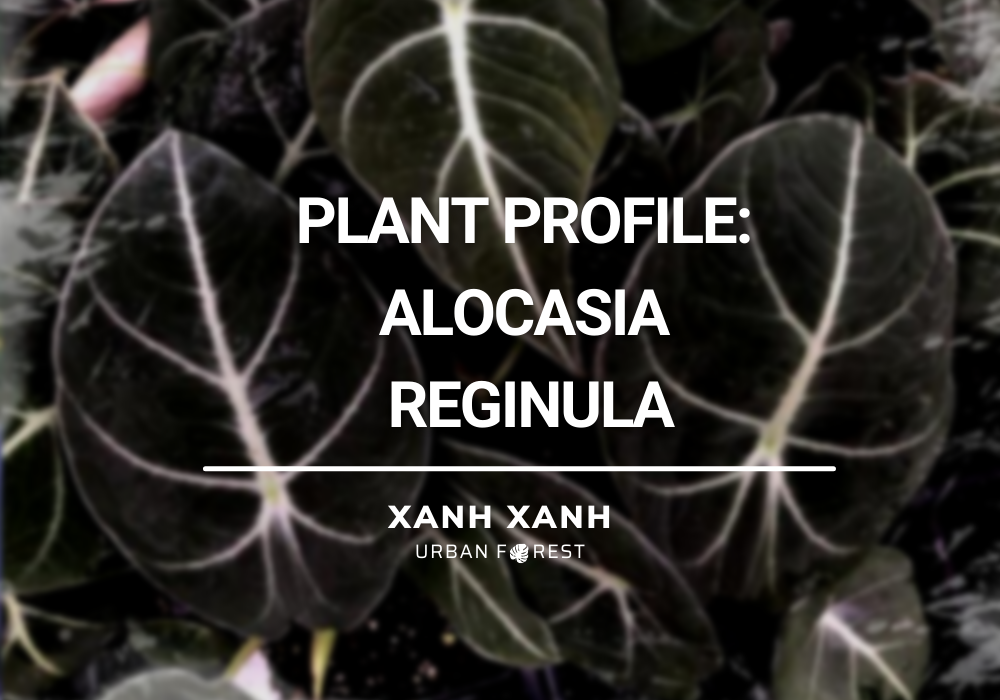The amazing Black Velvet Alocasia (Alocasia Reginula), or Little Queen, is unique and beautiful, with silver veins that stand out against the black, velvety backdrop of the wide leaf. The plant is particular rather than demanding. Continue reading this article to have more information about the lovely plant!
Introduction of Alocasia Reginula
Alocasia Reginula – This stunning Araceae family evergreen perennial is native to Southeast Asian jungle floors. Though the plant was previously quite rare, the magic of tissue culture is making it more widely available.
The dark leaves and prominent pale green, white, or silver veins of the Black Velvet stand out. Its heart-shaped, thick, succulent-like leaves have a velvety appearance and a stiff texture. The leaves are approximately six inches long and two and a half inches wide.
In the gloom beneath a forest canopy, the strikingly dark leaves evolved as a light-gathering strategy. All visible light waves are absorbed by the foliage, while their pale veins reflect them.
The Black Velvet is a rhizomatous perennial that stays compact, rarely growing taller than eighteen inches and wide. It goes dormant in cold weather but can be active all year if given enough light and warmth.
The plant’s preference for humidity makes it an ideal terrarium candidate; despite its small size, the Black Velvet won’t get lost in a sea of green. Alocasia Reginula ‘Black Velvet’ Care Summary Scientific Name Alocasia Reginula’Black Velvet’ Origin.

Alocasia Reginula Maintenance
Humidity
A minimum of 40% humidity is required to prevent foliage problems, but a range of 60% to 75% is ideal.
Light Requirements
Indirect light that is bright. It is more light tolerant than many other Aroids. Before watering, allow the top two inches of soil to dry. Root rot is a risk, so avoid overwatering or overpotting.
Soil Coarse, well-drained soil. A good ratio is two parts perlite and one part orchid bark to one part potting soil. Temperatures ranging from 59oF (15oC) to 80oF (27oC) or higher; they grow faster at the higher end. Temperatures below 55oF (13oC) are not tolerated, and both hot and cold drafts are disliked.
Fertilizer Apply a balanced fertilizer once a month. If using an all-purpose preparation, use half the strength.
Flowering
It’s highly improbable that this plant will flower inside. With a pale yellow spathe around a white spadix spike, the flowers are uninteresting.
With the exception of removing dead leaves, pruning is minimal.
Seed, offset separation, or rhizome division are all options for propagation.
Repotting is more effective when the roots are slightly entangled. Repotting should be done no more than once every 2-3 years, and pot sizes should only be increased slightly.
The most common pests are spider mites, however they are pest-resistant. Fungal leaf spot illnesses can be caused by excessive humidity or watering.
Toxicity
Calcium oxalate crystals are present, which can irritate the mouth and digestive system. It is poisonous to both humans and pets.
Light Requirements for Alocasia Black VelvetThe Black Velvet is not as light-hungry as some other aroids, but that doesn’t mean it enjoys the dark! After all, the plant’s entire strategy is to absorb every light particle it can. It necessitates medium to bright indirect lighting.
Over-intensity scorches the leaves; even excessively bright conditions can cause the leaves to lighten. Avoid placing your Black Velvet too close to an artificial light source if growing it in a terrarium.
If the light is too low, the plant will grow spindly or languish, so strike a balance. If the sun is too direct, move the plant away from the window or into a partially shaded spot.

Watering
Watering issues are one of the reasons why Alocasia Black Velvet care is sometimes regarded as finicky. Some sources suggest watering frequently to keep the soil moist, but not everything you read on the internet is true. (I apologize; I hope you were sitting down for that).
Overly moist soil is a recipe for disaster with this plant. They prefer higher humidity than many aroids and have a more temperate need for soil moisture.
Alocasia The rhizome and succulent-like leaves of Black Velvet make it susceptible to root rot. It requires oxygen around its roots and cannot survive in wet soil for long periods of time.
Here are some helpful hints:
Allow the top two or three inches of soil to dry out before rewatering to avoid overwatering. Allow the soil to dry out but allow the plant to breathe.
When watering, thoroughly wet the soil and allow the excess to drain out the exit holes. This aids in the removal of excess nutrient salts and completely rehydrates the medium.
If the plant is growing in warm weather, you can increase the amount of watering… However, keep a close eye on the soil. Don’t add water to a wet mixture.
In cool weather and/or when the plant is dormant, keep the soil dry.Because the plant is sensitive to minerals and pollutants, it is best to use purified water. Make sure to neutralize chlorine and chloramine at the very least.
Soil Requirements for Alocasia Black Velvet
The soil of Alocasia Black Velvet is the other half of the watering equation. To keep the roots aerated at all times – even after being thoroughly soaked – the mix should be coarse and free-draining.
In order to achieve this, the medium should contain a combination of structural and water-retaining elements. The Black Velvet prefers slightly acidic soil with a pH range of 5.5 to 6.5, so some organic matter is tolerated.
Here are some appropriate materials:
Peat Moss / Sphagnum
MossCoir de coco
Perlite
Pumice
Bark
Chips of wood
Sand, Coarse.
With that, you have reached the end of the article about Alocasia Reginula. Hopefully, this article provides you more knowledge of Alocasia Reginula.

